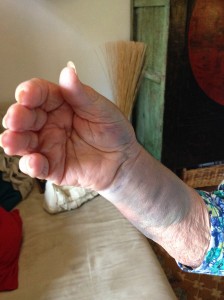Last week my 86 year old mother fell over an uneven paving slab on her way back from the library.  The swelling and bruising came out immediately and fortunately her wrist which took the impact of the fall wasn’t broken.
The swelling and bruising came out immediately and fortunately her wrist which took the impact of the fall wasn’t broken. 
She was badly shaken up by the event and took to her bed as a result.
Living in a location where a good number of the 100k residents are past retirement age according to a 2013 article Seaside town first place in country with average age of more than 70 and with many suffering impaired vision I decided to report the incident in the hope that the pavement might be fixed qucikly.
I was pleasantly surprised to discover a facility built on a Google Maps platform for reporting damaged pavements on the local government website (in 8 languages) and a twitter feed for instant access. So far so good.
The automatic response to my filing (and picture) was likewise encouraging and included the phrase ‘we will investigate’ along with a reference so I could track the progress.
Thinking of making a claim
Please consider the following points before you submit a claim. Making a claim can be a lengthy process and may not result in a pay-out. Any compensation is paid from public money so we will always be robust in our investigation of claims. The decision on liability will be based on the facts of each case and the law. Because of the legal defence available, on average, 70% of claims are unsuccessful.
The last sentence (my underlining) is instructive and made me ponder whether the use of the technology is for offensive or defensive purpose? Have we become such a litigious society that every corporate body feels compelled to get their retaliation in first and use social media as a broadcast and defensive mechanism not a collaborative platform?
I digress. Let’s be charitable and assume good intentions and applaud this as an example of good knowledge capture and retention. What we don’t as yet know is whether this will become a good example of how knowledge can be put to good effect and improve a process (or in this case fix something that isn’t working).
When Knowledge becomes an asset
Most organisations go down the Knowledge Capture route – they create buckets (increasingly in SharePoint) to store what they have captured to make sure that the best knowledge is available when a bid, a presentation or a decision is to be made. And that’s fine as far as it goes. Rarely do organisations add on the Knowledge Harvesting step. Here’s what that entails (drawn from Knowledge Associates’ 9 Step KM Process that acknowledges and builds on the original BP model of learning before, during & after):
- Conduct a learning or After Action Review
- At the end of that process ask the question does what we have discovered have the power to change/improve the way we (and those associated with us) work?
- If the answer is yes then you have what is known as a Knowledge Nomination and these should be considered at a separate gathering.
- Now convene, if you don’t have one as part of a Community of Practice, virtually or in person, a group of Subject Matter Experts with expertise on the process or way of working. Ask them to consider whether the Knowledge Nomination will improve our process and should be adopted.
- If they agree then change the process. If they don’t then make sure you have captured the Knowledge Nomination and the reason for its rejection.
I have always believed that the purpose of Knowledge Management is to help organisations make better decisions and work more effectively. The simple steps I’ve outlined above should help in acheiving those objectives.
I wait now with interest to see the outcome of the saga of the loose paving slab. Will the outcome merely be a repaired section of pavement or will the team think about how this was caused and put in place measures to stop it happening next time?

From Susan @ESCC proving that government does work!
Dear Mr Corney
Thank you for your request for an update to your report logged on 26 September. I am sorry to hear about your mother’s recent incident and hope she makes a full and speedy recovery.
The Duty Officer attended Southfields Road on Friday and had the paving slab made safe by removing the tree roots from underneath and relaying the slab.
Please accept my apologies that you did not receive this information following your initial contact relating to this matter.
Kind regards
Susan Draper
Customer Advisor
Communities, Economy & Transport | East Sussex County Council
And they very kindly shared with me the values statement they ask their employees to sign up to:
These behaviours were identified by staff during a series of events in 2013 and have been endorsed by CMT. They have been included in this appraisal paperwork to encourage appraisees to consider both what they have achieved over the past year and how they have achieved it.
Behaviour:
We are customer driven
This behaviour is about creating a dialogue of equals between the organisation and its customers and creating a shared commitment and way forward. It’s not about satisfying the customer at any cost – as this may sometimes be in conflict with the organisation’s needs. It is about establishing common ground first and working together to find the best solutions.
Measures:
• We seek to understand our customers’ concerns and needs by putting ourselves in their shoes
• We avoid one way interactions in which we tell things without listening. We check for understanding and seek to find common ground
• We speak positively to and about our customers
• We deliver on our promises to customers
Behaviour:
We deliver a great service
This is about the need to remember what we are trying to do. We can spend a lot of time doing things without always knowing its real value. This is about helping staff have a clear focus on the outcomes they are looking for and understanding the resources they have available to deliver them. It’s about challenging ourselves and others to do the best we can with the resources we have and to challenge others when they’re not delivering at the standard w expect.
Measures:
• We make sure we are clear about what we’re trying to deliver for our customers and the resources we have to deliver them
• We ask ourselves and others “why we are doing this and what results do we want?”
• We act when things are not being done in the right way or done at all
Behaviour:
We take responsibility
This is about people making decisions in “real time” without waiting for a formal meeting or pre-scheduled event and doing what needs to be done to deliver for our customers, without using “the organisation” as an excuse for doing nothing. It’s not about doing everything oneself, but about ensuring that a problem/need is going to be sorted. It’s about seeking clarity on what we can do and then getting on with it. It’s also about defining realistic timescales, being certain about the promises we make and not committing others to promises we can’t keep for them.
Measures:
• If I spot a problem or need I sort it out, even if it’s not in my job description
• I do what I say I’m going to do, when I say I’ll do it
• I seek clarity on what’s in my remit and do it without referring to my manager
Behaviour:
We work together as one Council
This is about people building relationships and thinking about other colleagues in delivering for customers – and about proactively seeking opportunities to do this both through the processes we use, and how we work. When we are at our best we work as One Council, strongly networked across the organisation, judging our success against the outcome for the whole population and the organisation not just against the interests of a particular group, team or department
Measures:
• I actively seek to work with colleagues and partner organisations to get the best results for our customer
• I make myself available to others, when asked to share ideas, provide help or work on common goals
• We always ask “who else do we need to talk to about this, who else needs to know?”
Behaviour:
We find better way of doing things
Behind this behaviour is the idea of creating an environment where people are not stuck in “the way we have always done things.” Creating the conditions for innovation can be done by promoting curiosity and enquiry, by seeking “unpredictable” answers. It’s not just about breakthrough products or quantum leap innovation but the day to day improvements that come from a critical view of things.
Measures:
• We ask the question: can it be done better or differently?
• We look outside the team, department, and organisation for ideas and examples of how things can be done
• When designing systems or processes we avoid predictable answers by involving diverse people, not just our close circle
• We welcome challenge from peers and share learning – both positive and negative
Now if I were testing these out at the end of this year I’d get them to use the ‘its all in a word’ technique wherein each person is asked to choose a word or value and then describe how he (or she) has seen it work in practice – to tell a story or anecdote. There’s a lot more to it and I once used it in an Atrium in Manila with 80 people who used it to describe the mission statement in action.